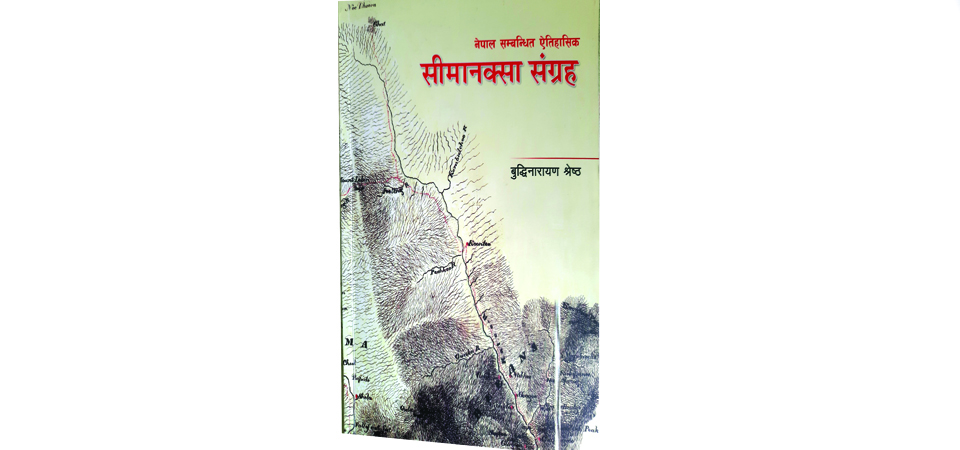An Edifice of Maps

Modnath Dhakal
Border Expert Buddhi Narayan Shrestha has come up with a collection of maps as a proof of the Indian encroachment of the Nepali territory in Kalapani, Lipulek and Limpiyadhura of Darchula district.
India has not only been deploying its military forces in the region for the last six decades, but it has also unilaterally published a map in November 2019 including 372 square km area of Nepal in its territory.
Nepal immediately protested the 'unilateral' act and sent diplomatic notes to India but the latter exhibited an utter indifference and did not respond to the call. Instead it developed a road to Lipulek, Nepal-China border, and inaugurated the same road in May 2020. The Indian Minister of Defense, Rajnath Singh, inaugurated the road.
The Indian aggression irked all Nepalis and the country witnessed a national unity in getting back the encroached land. The government also formed a team to collect the evidence to present as proof against the encroachment.
But Shrestha has individually collected dozens of maps from across the world since ancient times to present as the proof that Kalapani region and Limpiyadhura are Nepali lands. In his own words the book presents 'map as a proof to resolve the border issue, interpretation of maps, determination of the origin of the river, supporting documents to settle the boundary dispute, cartographic distortion and territorial aggression'.
The book is a precious collection of 90 different maps that tell stories against the Indian occupation of Nepali land. The writer has presented the greater Kalapani region in 44 different maps that are zoomed in on the location.
Author Shrestha has given the details of the origin of the maps, their creation and interpretations which helps the readers to understand the meaning in totality. He has specifically complained about Nepali authorities' incapability to help him with the required maps and other supportive documents while writing the book while some Indian writers had included the same maps in their books. All the maps were individually obtained by the author from various universities, libraries and organisations from the United Kingdom, United States of America, China, India and other countries.
'Seema Naksa Sangraha' is a focused presentation of Nepal's boundary, especially at the north-western side. It has a chronological presentation of the events that unfolded after India published the map including Nepali land in its territory. Satya Mohan Joshi's testimony of preparing the first map of the country helps the readers to understand the things in a historical perspective.
Likewise, the book has a detailed history of the cartographic practice in and out of Nepal to prepare the map of the country. Since most of the maps were designed and printed in India, they were deliberately distorted at various points. Maps published by Survey of India till 1860 show the river originated from Limpiyadhura as the Kali River while the same river is named as Kuti Yangti and Lipu River was mentioned as Kali in later editions.
A century later, Indian cartographic distortion reached its peak as it showed a small stream that started from a local Kali Temple as the Kali River.
While Sugauli Treaty, 1816 marked the Kali River as the borderline between Nepal and India, a map published in 1819, immediately after the Sugauli Treaty, clearly showed the river (Kalee River) originated from Limpiyadhura. The map prepared by Surveyor Captain W. J. Webb is available at British Library, India Office Records and Collections. Similarly, another map published in 1827, according to the Act of Parliament by James Hurst Surgh Hydrographer to the East India Company, also clearly mentions the river from Limpiyadhura as 'Kalee River'.
Shrestha undertook a herculean task to collect the cartographic evidence from around the world to prove that Kalapani region, Lipulek and Limpiyadhura are Nepal's territory and encroached by India. In addition to it, the book features a letter from Yogi Narahari Nath issued in 1817 which had sent information to villages east of the Kali River then.
Another letter featured in the book is written by the chieftains of Garbyang, Gunji, Budi, Chhangru and Tinker villages to then Prime Minister Chandra Shumsher about 116 years ago demanding to remove the embargo on land transfer.
In response, Chandra Shumsher had written a letter directing the village chiefs to resolve the problem on their own in a just way. The latest evidence was the records of the land tax payment. People of Limpiyadhura had been paying the land tax to the Nepal government till 1967. The government had those documents but Garbyang village now is in Uttrakhand Province of India.
The book can be a slap on the face of India which is encroaching the territory of its smaller neighbour for the last many decades and shamelessly running propaganda machines in and out of India to cajole the public opinion in its favour.
The book needs to be translated into English and Hindi as soon as possible and distributed in the international market. Although the printing of the book is clean, the crucial maps should have been printed in colour. Many maps are difficult to read and the reader should depend on the explanation made by the author.
Recent News

Do not make expressions casting dout on election: EC
14 Apr, 2022
CM Bhatta says may New Year 2079 BS inspire positive thinking
14 Apr, 2022
Three new cases, 44 recoveries in 24 hours
14 Apr, 2022
689 climbers of 84 teams so far acquire permits for climbing various peaks this spring season
14 Apr, 2022
How the rising cost of living crisis is impacting Nepal
14 Apr, 2022
US military confirms an interstellar meteor collided with Earth
14 Apr, 2022
Valneva Covid vaccine approved for use in UK
14 Apr, 2022
Chair Prachanda highlights need of unity among Maoist, Communist forces
14 Apr, 2022
Ranbir Kapoor and Alia Bhatt: Bollywood toasts star couple on wedding
14 Apr, 2022
President Bhandari confers decorations (Photo Feature)
14 Apr, 2022










